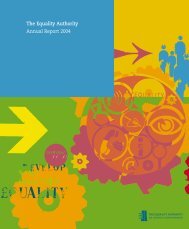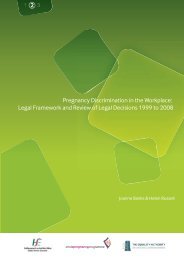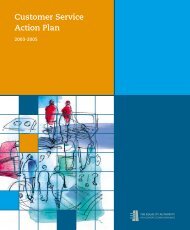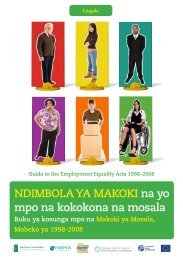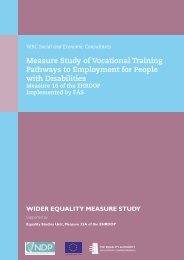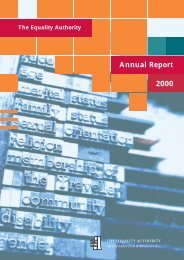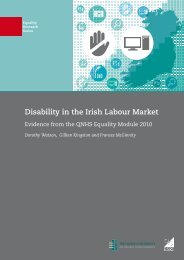Pregnancy and Employment: A Literature Review - Crisis Pregnancy ...
Pregnancy and Employment: A Literature Review - Crisis Pregnancy ...
Pregnancy and Employment: A Literature Review - Crisis Pregnancy ...
Create successful ePaper yourself
Turn your PDF publications into a flip-book with our unique Google optimized e-Paper software.
<strong>Pregnancy</strong> <strong>and</strong> <strong>Employment</strong>: A <strong>Literature</strong> <strong>Review</strong><br />
The study found that 36% of women who gave birth in 1946 were downwardly mobile when they returned to work.<br />
More surprisingly, the level of occupational downgrading was the same for their daughters when they returned<br />
to employment following childbearing during the 1960s <strong>and</strong> 1970s. Approximately 30% of each cohort resumed<br />
employment within five years of the birth of their youngest child. The median time before return was eight years<br />
<strong>and</strong> one month for the 1946 cohort of mothers. 34 The data consisted of a nationally representative sample (5,362)<br />
of women who gave birth during the same week in 1946. The cohort of children who were born in 1946 was<br />
followed up with surveys from school-leaving age up to 32nd birthday (Joshi & Hinde, 1993, p206).<br />
A more recent cohort of women in the UK was investigated by Smeaton (2006). Smeaton uses a classification<br />
of nine occupational groups to investigate downward occupational mobility following childbearing, using the<br />
National Childhood Development Study sample of women born in 1958, <strong>and</strong> the 1970 British Cohort Study<br />
cohort, who were aged 30 when surveyed in 2000. The analysis includes returns to work that occurred ‘many<br />
years’ after the birth. The maximum length of career break is not specified but, to ensure comparability between<br />
the two samples, childbirth <strong>and</strong> the return job have to be observed by the age of 31 years in both cohorts. The<br />
nine occupational categories used are: Manager; Professional; Associate Professional; Clerical; Craft <strong>and</strong> Related<br />
Manual; Personal <strong>and</strong> Protective; Sales; Plant <strong>and</strong> Machinery; Elementary. For managers, professional <strong>and</strong> associate<br />
professional downward moves are defined as a transition to clerical or below. For clerical occupations, downward<br />
mobility consists of moves to craft <strong>and</strong> related manual workers or below. For personal <strong>and</strong> protective services,<br />
downward moves involve transitions to plant <strong>and</strong> machinery operatives or to elementary occupations.<br />
The downward mobility rate for women born in 1958 was 36%, identical to that found in the earlier cohorts by<br />
Joshi <strong>and</strong> Hinde (1993), using different definitions. Among the 1970 birth cohort, the proportion of women who<br />
experienced occupational downgrading on their return to employment had declined to 22%. Smeaton’s study<br />
also reveals some important differences in the risks of downgrading for occupational groups. The women most<br />
vulnerable to downward mobility were those in managerial jobs <strong>and</strong> craft occupations. This was true for both<br />
cohorts but in the earlier cohort clerical workers also had an above-average risk of demotion. Smeaton attributes<br />
the high levels of downward mobility following childbirth among managers to organisational cultures which expect<br />
managerial staff to work long hours, leading women to change jobs. Similarly, the lack of part-time opportunities<br />
for craft workers is thought to explain their higher risk of downward mobility. However, the results for the higher<br />
occupational groups should be interpreted with some caution. The analysis is restricted to women aged under<br />
31 <strong>and</strong>, as noted in the previous chapters, mothers in the higher occupational <strong>and</strong> educational categories tend to<br />
delay first births until their thirties (Smeaton, 2006).<br />
The study of women returners in Irel<strong>and</strong> by Russell et al (2002) also includes women with long periods outside the<br />
labour market. The study found evidence of occupational downgrading among re-entrants at the aggregate level.<br />
Using longitudinal data from the 1994 to 1999 Living in Irel<strong>and</strong> Panel Surveys, it was found that the jobs women<br />
returned to following a spell outside the labour market were much more likely to be concentrated in lower-level<br />
occupations in the personal-service sector (e.g. shop assistant, domestic work, cleaning, etc) when compared to<br />
their previous employment. Russell et al (2009) investigate occupational downgrading for the same women at the<br />
individual level. Changes in occupational position pre <strong>and</strong> post-employment break were investigated using the<br />
International Socio-Economic Index of Occupational Status (ISEI). Upward <strong>and</strong> downward moves were defined as<br />
those entailing a difference of at least five points between last job <strong>and</strong> return job. The study found that a third of<br />
women re-entrants return to a job that is of lower status than their previous job, half remain at the same status<br />
level <strong>and</strong> 16% experienced upward mobility. Erosion of status was more common for women who had spent longer<br />
periods out of the labour market (see Table 4.1): 42% of women who had a break of employment of 10 years or<br />
more were downwardly mobile. Downgrading was less common among women who had spent less than two<br />
years out of the labour market, but was still experienced by just under one-quarter of the group. However, this was<br />
counter-balanced by 17% of this group who were upwardly mobile on their return to employment.<br />
34 The median return time was not reported for the 1946 birth cohort.<br />
PAGE 39




